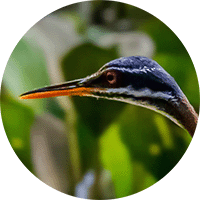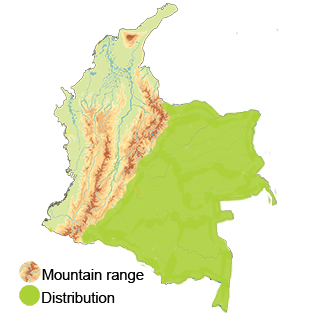Amazonian Sunbittern
Appearance: The Amazonian Sunbittern exhibits a unique and striking appearance with its plumage adorned in patterns of black, white, and chestnut colors. It has a sleek, slender body with long legs and a wingspan typically measuring 50-60 centimeters. Its wings are especially notable for their intricate patterns resembling eyespots, which serve as camouflage and are used for intimidation purposes.
Habitat: Sunbitterns primarily inhabit tropical regions of Central and South America. They prefer forested areas near streams, rivers, and other water bodies where they can find suitable habitat for foraging and nesting.
Behavior: Sunbitterns are known for their elusive nature and can be challenging to spot due to their superb camouflage and shy behavior. They are often found foraging along streams and rivers, where they search for aquatic insects, small fish, and crustaceans. Sunbitterns are solitary birds and are generally more active during the day, especially in the early morning and late afternoon.
Breeding: Breeding habits of Sunbitterns include establishing nests near water sources, usually concealed among vegetation for protection. They typically lay one or two eggs per clutch, and both parents take part in incubating the eggs and caring for the young.
Conservation Status: The conservation status of the Amazonian Sunbittern is currently of least concern according to the IUCN.
Distribution
Eastern Andes: This bird species is also known to inhabit areas along the eastern slopes of the Andes, including regions like Meta and Caquetá.
Amazon Rainforest: The Sunbittern can be found in lowland regions of the Amazon Rainforest in Colombia, including areas within the departments of Amazonas, Putumayo, Vaupés, and Guaviare.
The Sunbittern is found near water sources such as rivers, streams, and wetland areas. It prefers lush, forested habitats where it can hunt for fish, insects, and other small aquatic prey.
Taxonomy
The Amazonian Sunbittern (Eurypyga (helias) helias)
- Kingdom: Animalia
- Phylum: Chordata
- Class: Aves (Birds)
- Order: Eurypygiformes
- Family: Eurypygidae
- Genus: Eurypyga
- Species: Eurypyga helias
- Subspecies: helias
Vocalization
Soft Calls: These are gentle, soft calls that the Sunbittern may use to communicate with its mate or while nest-building. These calls are not loud or particularly distinctive.
Alarm Calls: When the Sunbittern senses danger or feels threatened, it may emit alarm calls to warn others in its vicinity. These calls may be sharper and more urgent than its regular vocalizations.
Courtship Calls: During the breeding season, the Sunbittern may engage in courtship displays that involve soft calls and specific vocalizations to attract a mate.
Aggressive Calls: In territorial disputes or confrontations with other individuals, the Sunbittern may produce aggressive vocalizations to establish dominance or defend its territory.





